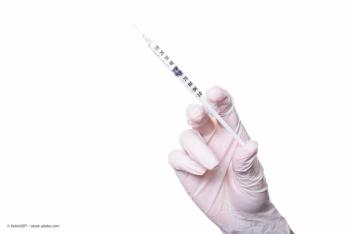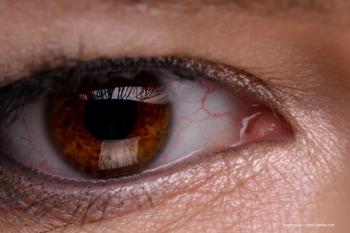
Impressions and take away points from Patient Case #1
A uveitis specialist discusses impressions and key take away points from patient case.
Eduardo Uchiyama, MD: My initial impression about this case is that we have a patient in her 60s, female, with symptoms for about 2 years. Upon examination, she has good vision, but she also has mild inflammation in the anterior chamber, moderate inflammation in the vitreous, and multiple chorioretinal lesions on both eyes.
Based on all the information that I have, the patient has panuveitis. And when I have a patient that has the involvement of the posterior segment, I need more imaging. In this case, we ordered a fluorescein angiogram [FA], and an ICG [indocyanine green angiography] angiogram to see what the extent of the inflammation is.
A patient like this one presents several challenges. First, the patient had symptoms for about 2 years, and I'm sure that has seen several doctors about this complaint. The problem with this is that the patient has good vision; the vision was 20/30 and 20/25. And the degree of inflammation is not severe, so if you are not paying too much attention to the intraocular structures, you may miss some of the signs of inflammation. That's number one. Second, sometimes we think that when a patient has good vision that indicates that the problem might not be severe. And in a situation like this, this is not the case. And we can see, on angiogram the severity of the inflammation. And as we know, if we leave a patient with active inflammation for too long, then that vision 20/30 or 20/25 may not stay there for long.
When we deal with a patient that has inflammation involving the posterior segment, angiograms are very useful. In a case like this, for example, we obtained a fluorescein angiogram, and also an indocyanine green angiogram. Both give us different information to try to assess the degree of inflammation, and also to help us make the diagnosis. In this patient, we see that on the angiogram, the patient had severe vasculitis and vascular exudation, even though the vision was good. On an ICG, the ICG findings are diagnostic. This patient has multiple hypercyanescent lesions throughout the fundus. So based on this patient, we'll need to get some bloodwork to make the final diagnosis.
In terms of workup, on the initial visit, I get imaging, like the FA, ICG, and OCT [optical coherence tomography]. Then depending on the severity of the condition, we order bloodwork that is tailored to the patient. There is no specific or standard uveitis workup.
In a patient like this, we have to make sure we rule out infection causes. Like we're always taught during training. When you deal with a patient with uveitis, you have to rule out syphilis, sarcoidosis, and tuberculosis. For syphilis, we order a treponemal test, like treponema pallidum antibody. For tuberculosis, we get a quantiFERON gold. For sarcoidosis, some people order an ACE or the lysozyme. And most of us order some type of chest imaging, either a chest x-ray or CT [computed tomography] of the chest with contrast. How can we rule out infections? I would say at first is the physical examination. If there are some pathognomonic signs of infection, like if we see a patient with free-flow retinitis, or a focal area retinitis, or corneal lesions, we may suspect a herpetic or a toxoplasmic infection. Or with the bloodwork, like previously mentioned.
In this particular scenario, based on the clinical findings, I'm suspicious about birdshot retinochoroidopathy, so in our workup, we're going to also add an HLA-A29, to see if the patient has that positive finding, which in addition to the ICG imaging will give us a diagnosis.
In this particular patient, the bloodwork showed a positive HLA-A29, so a diagnosis of birdshot retinochoroidopathy was made. In terms of treatment, the patient has different options. We can either treat the disease locally or systemically. In terms of local treatment we know that this condition needs long-term treatment, so what I would usually do is either inject steroids intraocularly or periocularly, initially. And then, depending on the response and depending on the side effects, we may consider a longer-acting treatment, like YUTIQ [fluocinolone acetonide intravitereal implant]. That is a fluocinolone implant that may last up to 3 years. In terms of systemic treatment, we can consider treatment with antimetabolites, such as methotrexate or mycophenolate, or a biologic, like an anti-TNF-alpha blocker like Humira [adalimumab].
How to select the treatment depends on the patient's characteristics. We explain all the options to the patient, and the patient is who finally makes the decision.
In this particular case, the patient elected to be treated systemically. We started the patient on oral prednisone, about 1 mg/kilo, to try to control the inflammation acutely. After that, we started the patient on a TNF blocker, specifically Humira. With that, we have a long-term control, and the patient may need also some local treatment, depending on the response, because as we know, the treatment with systemic medications that are nonsteroids, such as antimetabolites or Humira, don't work right away. Especially at the beginning, the patient may need help with the local treatment as well.
The takeaways from the round table discussion about this patient were first, that it's very important to classify the uveitis when we see it. And in cases like this one when there is the involvement of the posterior segment, you have to be very careful, because patients who have inflammation, either intermediate uveitis, posterior uveitis, or panuveitis, are at the highest risk of vision loss if proper treatment is not given. Another important thing is how to differentiate infectious etiologies from non-infectious. As well as how to act and how to titrate different medications and try to control the inflammation as soon as possible.
Transcript Edited for Clarity
Newsletter
Keep your retina practice on the forefront—subscribe for expert analysis and emerging trends in retinal disease management.












































